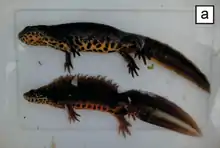Anatolian crested newt
The Anatolian crested newt (Triturus anatolicus) is a newt species endemic to northern Anatolia in Turkey. Before its description in 2016, it was first considered to belong to the southern crested newt (Triturus karelinii) and then the Balkan crested newt (Triturus ivanbureschi). The three species form a complex of morphologically indistinguishable cryptic species. Genetic data demonstrated the Anatolian crested newt to be distinct from the other two species, although it hybridises with the Balkan crested newt at its western range end.
| Anatolian crested newt | |
|---|---|
 | |
| Female (above) and male (below) | |
| Scientific classification | |
| Kingdom: | Animalia |
| Phylum: | Chordata |
| Class: | Amphibia |
| Order: | Urodela |
| Family: | Salamandridae |
| Genus: | Triturus |
| Species: | T. anatolicus |
| Binomial name | |
| Triturus anatolicus Wielstra & Arntzen 2016 | |
 | |
With its two closely related species, the Anatolian crested newt is more stockily built than the other crested newts, and reaches 10–13 cm in length. It is semiaquatic, spending most of the year on land and only returning to water for breeding. The species does not seem to be immediately threatened, although a formal IUCN Red List assessment has not been conducted yet.
Systematics and taxonomy
The Anatolian crested newt was described by Ben Wielstra and Jan Willem Arntzen in 2016.[1] Mitochondrial DNA data had already suggested that it was a separate species in a 2013 study, but the authors had preferred to await a more detailed analysis before formal species description and temporarily included it in the Balkan crested newt (Triturus ivanbureschi), which had been split from the southern crested newt (T. karelinii).[2] Nuclear DNA analysis then confirmed that its populations form a distinct gene pool, although it detected a hybrid zone where the species' range borders that of its sister species, the Balkan crested newt, in western Anatolia.[1]
| |||||||||||||||||||||||||||||||||||||||||||||||||||
| Position of the Anatolian crested newt in the phylogenetic tree of genus Triturus, as suggested by analysis of complete mitochondrial DNA.[3] |
Description
No morphological criteria are known to distinguish the Anatolian crested newt from the Balkan and the southern crested newt; the three are cryptic species. Like the other two closely related species, it is a rather stout newt which measures 10 to 13 centimetres (3.9 to 5.1 in) and has 12–13 rib-bearing vertebrae. Its back and sides are brown–black with darker spots; the underside is orange with black blotches whose pattern is variable among individuals. Females do not develop a crest and swollen cloaca, and have a smaller tail fin during the aquatic phase.[1]
Distribution and habitats
The species is endemic to northern Anatolia on the Black Sea coast, where its range extends roughly from the Bosphorus and Bursa in the west to Trabzon in the east, reaching no more than 200 kilometres (120 mi) inland.[1]

Behaviour and ecology
Like other Triturus species, the Anatolian crested newt initially develops in the water, but spends most of the year in shady habitats on land as an adult. It returns to breeding ponds every year, where males develop a conspicuous dorsal crests and court the females. Eggs are folded in leaves of water plants.[4]
Threats and conservation
The Anatolian and the Balkan crested newt, split only recently from the southern crested newt, have not yet gone through a Red List assessment according to the International Union for the Conservation of Nature's criteria. A previous assessment reported the southern crested newt, including both now-accepted species, as widespread, with no immediate threats known, in Turkey.[5]
All crested newts are listed in the Bern Convention (appendix II) and the EU Habitats Directive (annex II and IV), which prohibit capture, disturbance, killing, trade, and destruction of habitats.[6][7]
See also
References
- Wielstra, B.; Arntzen, J.W. (2016). "Description of a new species of crested newt, previously subsumed in Triturus ivanbureschi (Amphibia: Caudata: Salamandridae)". Zootaxa. 4109 (1): 73–80. doi:10.11646/zootaxa.4109.1.6. ISSN 1175-5334. PMID 27394852.

- Wielstra, B.; Litvinchuk, S.N.; Naumov, B.; Tzankov, N.; Arntzen, J.W. (2013). "A revised taxonomy of crested newts in the Triturus karelinii group (Amphibia: Caudata: Salamandridae), with the description of a new species". Zootaxa. 3682 (3): 441–53. doi:10.11646/zootaxa.3682.3.5. ISSN 1175-5334. PMID 25243299.

- Wielstra, B.; Arntzen, J.W. (2011). "Unraveling the rapid radiation of crested newts (Triturus cristatus superspecies) using complete mitogenomic sequences". BMC Evolutionary Biology. 11 (1): 16. doi:10.1186/1471-2148-11-162. ISSN 1471-2148. PMC 3224112. PMID 21672214.

- Jehle, R.; Thiesmeier, B.; Foster, J. (2011). The crested newt. A dwindling pond dweller. Bielefeld, Germany: Laurenti Verlag. ISBN 978-3-933066-44-2.
- Arntzen, J. W.; Papenfuss, T.; Kuzmin, S.; Tarkhnishvili, D.; Ishchenko, V.; Tuniyev, B.; Sparreboom, M.; Rastegar-Pouyani, N.; Ugurtas, I. H.; Anderson, S.; Babik, W.; Miaud, C.; Isailovic, J. C. (2009). "Triturus karelinii". IUCN Red List of Threatened Species. 2009: e.T39420A10235366. doi:10.2305/IUCN.UK.2009.RLTS.T39420A10235366.en.
- "Convention on the Conservation of European Wildlife and Natural Habitats". Bern: Council of Europe. 1979. Archived from the original on 2015-09-26. Retrieved 2016-05-08.
- "Council directive 92/43/EEC on the conservation of natural habitats and of wild fauna and flora". Act No. 1992L0043 of 1 January 2007. Retrieved 2016-05-08.
